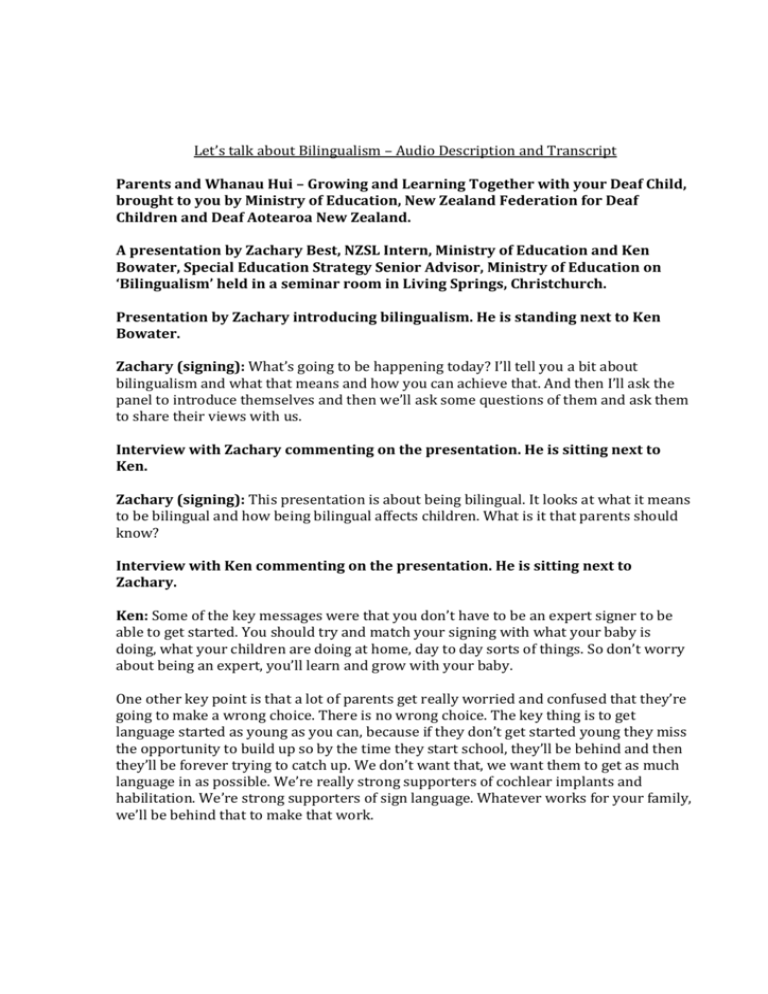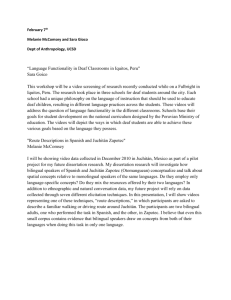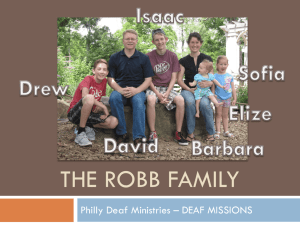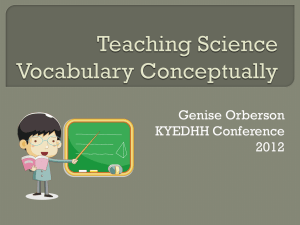Let`s talk about bilingualism - New Zealand Federation for Deaf
advertisement

Let’s talk about Bilingualism – Audio Description and Transcript Parents and Whanau Hui – Growing and Learning Together with your Deaf Child, brought to you by Ministry of Education, New Zealand Federation for Deaf Children and Deaf Aotearoa New Zealand. A presentation by Zachary Best, NZSL Intern, Ministry of Education and Ken Bowater, Special Education Strategy Senior Advisor, Ministry of Education on ‘Bilingualism’ held in a seminar room in Living Springs, Christchurch. Presentation by Zachary introducing bilingualism. He is standing next to Ken Bowater. Zachary (signing): What’s going to be happening today? I’ll tell you a bit about bilingualism and what that means and how you can achieve that. And then I’ll ask the panel to introduce themselves and then we’ll ask some questions of them and ask them to share their views with us. Interview with Zachary commenting on the presentation. He is sitting next to Ken. Zachary (signing): This presentation is about being bilingual. It looks at what it means to be bilingual and how being bilingual affects children. What is it that parents should know? Interview with Ken commenting on the presentation. He is sitting next to Zachary. Ken: Some of the key messages were that you don’t have to be an expert signer to be able to get started. You should try and match your signing with what your baby is doing, what your children are doing at home, day to day sorts of things. So don’t worry about being an expert, you’ll learn and grow with your baby. One other key point is that a lot of parents get really worried and confused that they’re going to make a wrong choice. There is no wrong choice. The key thing is to get language started as young as you can, because if they don’t get started young they miss the opportunity to build up so by the time they start school, they’ll be behind and then they’ll be forever trying to catch up. We don’t want that, we want them to get as much language in as possible. We’re really strong supporters of cochlear implants and habilitation. We’re strong supporters of sign language. Whatever works for your family, we’ll be behind that to make that work. Presentation by Zachary continued. PowerPoint presentation on ‘Understanding the term “bimodal”’. The text on the slide reads: There are many spoken languages; there are many sign languages. Those who can use both are biomodal. Zachary (signing): One word, there you see, ‘bimodal’. You often see that term together with ‘bilingual’. So, to learn more about these two terms we are going to divide into two groups, one bilingual and the other bimodal. So, what’s bimodal? Well the world obviously has many different spoken languages. Too many for me to even start listing. Lots! There is also a huge range of sign languages too. Bimodal means you can use both spoken language and signed language so you can sign and you can speak. So you can use both. For example, myself I am bimodal as I can both speak and sign. Ken continues the presentation. Ken: So for today we’re really talking about being able to speak and being able to sign and any combination of those we are talking about today. And trying to explore how that works in families. Zachary continues the presentation. Zachary (signing): This also means you are using both your left and right sides of your brain. Signing is visual and so uses that part of the brain. Spoken language uses the auditory parts. PowerPoint presentation on ‘Why bimodal?’. The text on the slide reads: Being bilingual/bimodal is healthy for the brain and cognitive development; the two modes complement each other and enhance language and learning – they get a richer experience; when technology fails, we have backup. Zachary (signing): Each mode uses a different part of the brain’s function. Ellena and Justin, parents, speaking about learning to be bilingual. Ellena: For us we have been bringing up our family to be bilingual. Until we had our son, we had nothing to do with sign language or anything like that previously so in the last five years, we just started very basic learning NZSL and for the last couple of years we’ve had a private tutor who’s been teaching us and that’s very important for us to have our son to be brought up bilingual, just so he can relate to being deaf and as he gets older, be with deaf peers and just to really love who he is and to know that being deaf is okay and he can mingle with deaf people and hearing people and it doesn’t really matter. A participant in the workshop asks a question. What are the challenges, the requirements of parents to teach sign language, to learn sign language by themselves and to teach sign language to their children? Justin responds to the question. Justin: I think for me personally it’s actually been one of the hardest journeys I’ve actually been on. It gets to the point for me, you know learning sign language after an hour my brain just goes dead, absolutely dead. Together we’re about level 2 in sign language, but what we’ve done with our child, we’ve tried to always stay up with about his age group. Not thinking ‘I’ve got to get to level 20’, because that’s not the reason for learning sign language. For me personally it’s for learning to communicate with my son and now our journey’s changing because he’s going to school so there’s a different journey again but we’ve come through the last nearly 5 years and as we’ve grown, the support that we’ve got, as we’ve looked for it, our tutor Debra and things like that has jut been absolutely fantastic and a great experience. It’s been so encouraging. But to tell you honestly, it’s been one of the hardest things I’ve ever done. A participant in the workshop asks a question. Would teaching her sign language take the focus off the spoken language or maybe she will be more interested in communicating through signs and would not focus so much on language and that’s why we refrained from teaching her sign language this time. So maybe once she develops her language then we feel we’ll go for it. So what is the advice of the parents who’ve already used both? Justin responds to the question. Justin: For example, we attend a church reading and during that church time we’re allowed to comment. We do what we call ‘watch tower’, so we’re Jehovah’s Witnesses, so there’s a watch tower study. The kids are allowed to comment about an article that we might be discussing as a congregation. Now for Charlie to hear us properly, we have to actually literally shout at him, so ‘Can you answer this?’ ‘What?’ ‘Can you answer this?’. Everybody can hear you in the audience because he can’t pick it up. Now a cochlear, cochlear are a wee bit better than hearing aids, but if we sign it to him he gets it, and he’ll verbally say over a microphone at four years old. So for us, it doesn’t supersede. He’ll do what he wants to do, simple as that. He chooses to use his voice on more occasions and then at some stage he will sign. Even as we sit down as a family discussing things, sometimes he signs, sometimes he speaks. Toby and Katya, parents, comment about having a tutor in the home. Katya: The ways to get around not being able to find, for example community classes that suit a child or families with children and ways to get around that. So there was one family that decided they would have a tutor come to their home and then other families would come and join them and so that they could learn in an environment that was suitable and what they were learning was catered directly for the families and children, so that sounded like a really good idea. A participant in the workshop comments on advisors coming to your home. Just to share with you and also go back and talk to your advisor on Deaf children and they can arrange the First Signs class. They come to your place, they come over on the weekends, in the evenings. They come according to what suits you best and yeah, they come to your home. You can invite your friends, your pre school teachers to your place and you all can learn together which is great. Ellena and Justin comment on their journey. Justin: Every time that we meet parents that are in very similar circumstances as what ours is, and maybe they vary a little bit, but you learn so much. You get parents that now their children are a lot older, they’ve been through some of the events that we’re going through. It’s like a reassurance. It’s almost like someone getting behind you and saying ‘It’s going to be alright. This is the outcome, it’s very positive’ and it just gives you a little bit more confidence in the system that’s in place and what’s available to you there as well and also just sharing your frustrations. The amount of parents that are really just frustrated and angry about everything. Ellena: And I feel that we’re kind of 5 years into our journey and we were the parents who had the young baby who was newly diagnosed and we knew nothing and we really relied on the parents that were in our situation at the time that had the older children who had been there done that and the information they gave us at the time was just wonderful and so I know us two now, we want to be able to try and pass that information on to new families coming up now to help them in anyway that we can. Ken discusses feedback from parents at the workshop. He is sitting next to Zac. Ken: The feedback we’ve had from the parents is that they were just blown away by finally having a chance to actually get together with each other. That was the most important thing, meeting and seeing and talking with other deaf parents of deaf children and seeing that their children are just like everybody else, they just want to get together. And for the parents to be able to meet with people who actually can set out information to help them make their decisions, that was another really important part of the weekend. PowerPoint on Top Tips for ‘Let’s talk about Bilingualism’. Top Tips: Signed and spoken language development complement and support each other – one does not detract from the other. You don’t have to be an expert – learn and grow with your baby. There is no wrong choice – use what works for you and your family. Connect with other parents and learn together. Don’t put it off – to maximise language development it is critical to start young. Signed communication can start younger than spoken language can. Ministry of Education logo, Deaf Aotearoa New Zealand logo, NZ Federation for Deaf Children logo.







